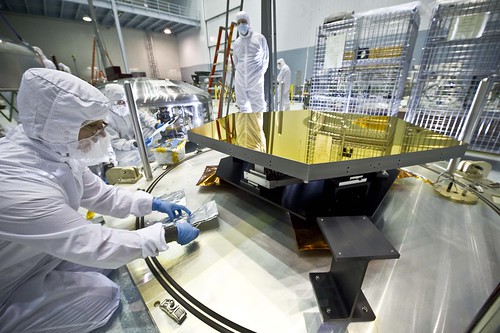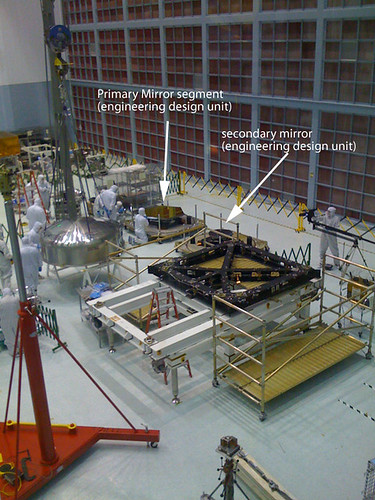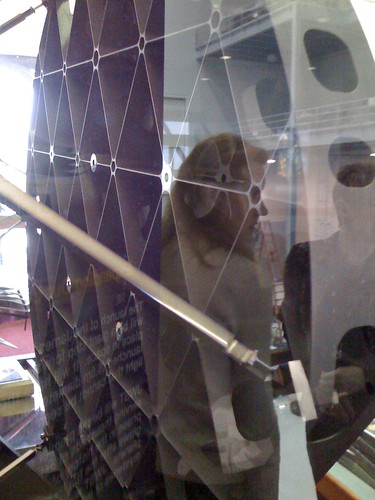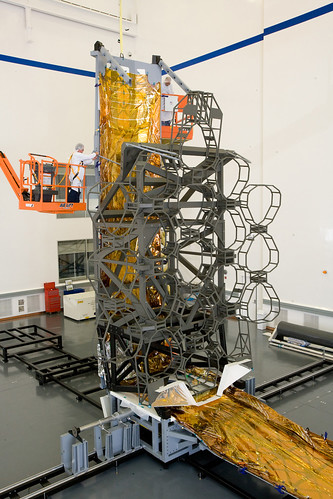Reflections on Webb’s Mirrors
- By Maggie Masetti
- March 23, 2011
- 3 Comments
Working at Goddard can be really exciting – there’s nothing like seeing a mission come together before your eyes. I’ve worked on the James Webb Space Telescope project for a number of years, but deliveries of flight and test hardware are becoming more and more regular. It makes everything seem much more real.
The latest piece of Webb technology to arrive at Goddard are one of our primary mirror segments and a secondary mirror. These mirrors are what is known as engineering design units (EDU) – they precede the flight hardware in assembly and testing. (They are also flight spares.)
Since the flight primary mirror segments will look just like the EDU, it’s pretty exciting to see one for real.
We had a professional photographer and videographer in the cleanroom, but I (and a bunch of others) were watching the action through the cleanroom windows. Here are a few shots of the mirror being inspected after the cover was removed from it, as well as my on-the-scene iPhone shots.

Credit: NASA/Chris Gunn

Credit: NASA/Chris Gunn

Credit: NASA/Chris Gunn
On the right here, you can see them lifting the cover off the secondary mirror EDU with a crane. See the guy that has a strap across his shoulder? (You can see the black strap on his back.) He’s actually operating the crane. The primary mirror EDU is already uncovered.

The primary mirror segment hexagonal and gold. The mirrors will all have a very thin (only nanometers thick) gold coating to increase their reflectivity of infrared wavelengths.

Another new addition to our cleanroom observation area – this is our mirror demonstrator. The full name is the “Subscale Beryllium Mirror Demonstrator (SBMD). It was the first Beryllium technology mirror developed for Webb.

The SBDM demonstrated three new technological innovations:
- It was made out of a new type of Beryllium (O-30), an advancement from the Beryllium used on Spitzer (I-70). This kind is more uniform and performs better over the very cold temperatures that Webb will operate at.
- It’s the lightest weight Beryllium mirror ever made it this size. The ribs in the back are less than a millimeter thick yet it maintains structural integrity. New machining advances were made to demonstrate this. It’s twice as light per unit area as the Spitzer primary mirror and almost 20 times lighter per unit area than the glass Hubble primary mirror.

- It met with the optical quality required for Webb (2.5x better performance than required on Spitzer.)
The SBDM is only ~half a meter in diameter. The full-sized primaries are 1.3 meters in diameter.
This morning, both mirrors were moved closer to the viewing area, so I was able to snap a few more pictures! A small sample section of backplane is to the far right. (It’s called the BESTA.)


The primary mirror segments (18 of them total) will be mounted on a full-sized backplane, which will look something like this full-sized test version! It will be so impressive to see this, full-sized, with all the mirrors on. I can’t wait!

Credit: Northrop Grumman
And just to give a better sense of scale, here’s Northrop Grumman’s full-scale model with some of the folks on the Webb team.

Credit: NASA



Thanks for sharing this impressive presentation.
I love NASA !!!
Nice!!
Wow, that’s amazing to see all that come together right before your eyes!